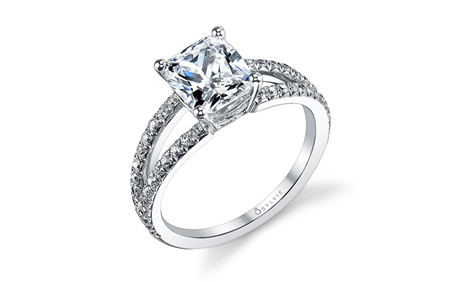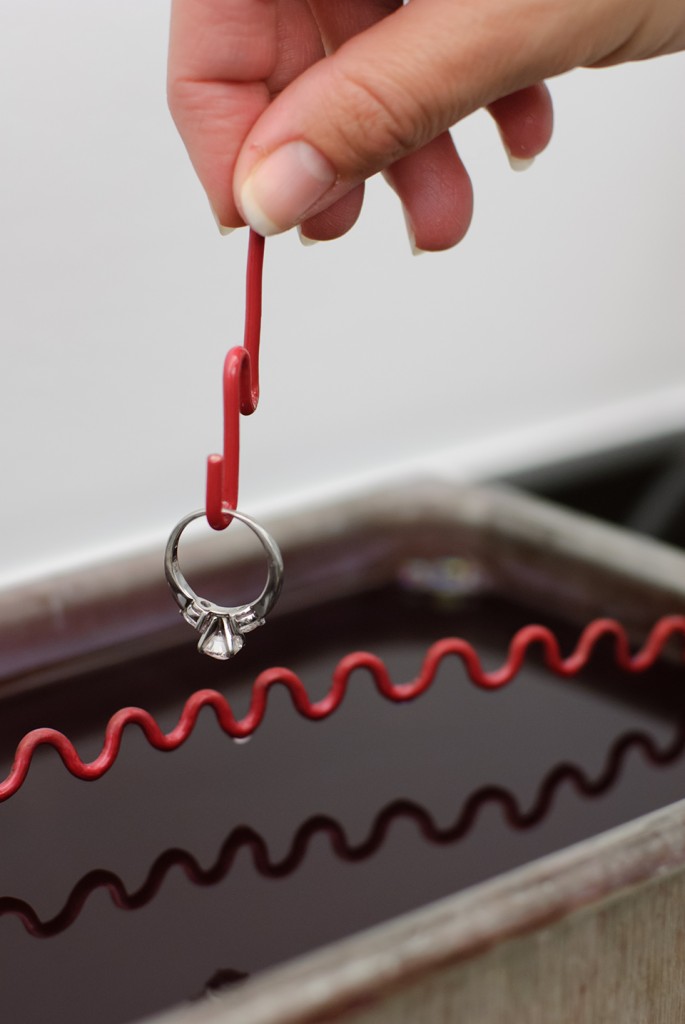Winter is here, and that means the holiday season is upon us! You might have already unpacked your winter blankets from their storage closet and maybe your down coat as well. But have you given your jewelry a good cleaning lately?
Holiday parties, family events, and the sparkle of the season provide plenty of reasons to dust off your jewelry box and give its contents some shine.
Do you know how to clean jewelry safely? It’s not always as easy as stopping at the store and picking up an at-home jewelry cleaner. Certain metals and gemstones require different cleaning methods to avoid accidentally damaging them.
We dispel some common myths about cleaning jewelry at home, and provide the facts you need to clean your jewelry safely.
1. Ultrasonic Cleaners
MYTH: You can clean all of your jewelry with an ultrasonic cleaner because it’s specifically made for jewelry.
FACT: Your jeweler may use this type of professional cleaning machine at his shop, but it requires care to use it correctly and appropriately at home. How does an ultrasonic cleaner work? It sends low frequency wavelengths through a liquid solution to remove the dirt and buildup on your jewelry. It is especially helpful for removing dirt in hard-to-reach places like beneath diamonds. However, many types of gemstones can be damaged by an ultrasonic cleaner, though use of just the solution will assist in removing most compounds. See our do’s and don’ts on ultrasonic cleaning before you start, to avoid any unnecessary harm to some of your most prized jewelry pieces.
2. Ammonia-based Household Cleaner
MYTH: Ammonia-based household cleaners are good for cleaning all types of gems and jewelry.
FACT: Organic and porous gemstones (like coral, pearl and turquoise) should not be exposed to the harsh chemicals found in ammonia-based cleaners (like window cleaner). However, it is safe to clean most diamond jewelry with a mild solution containing ammonia unless the diamond has been treated with a non-permanent substance like a coating. Use a soft, clean toothbrush that is reserved for cleaning your jewelry. Be gentle – you don’t want to loosen any stones, especially if the setting is fragile or older as in estate jewelry. Also, try to not clean your jewelry too close to an open drain in the sink. If you are cleaning by a sink, be sure there is something to prevent your jewelry from falling down the drain.
3. Commercial Jewelry Cleaning Solution or Over-the-Counter Jewelry Polish
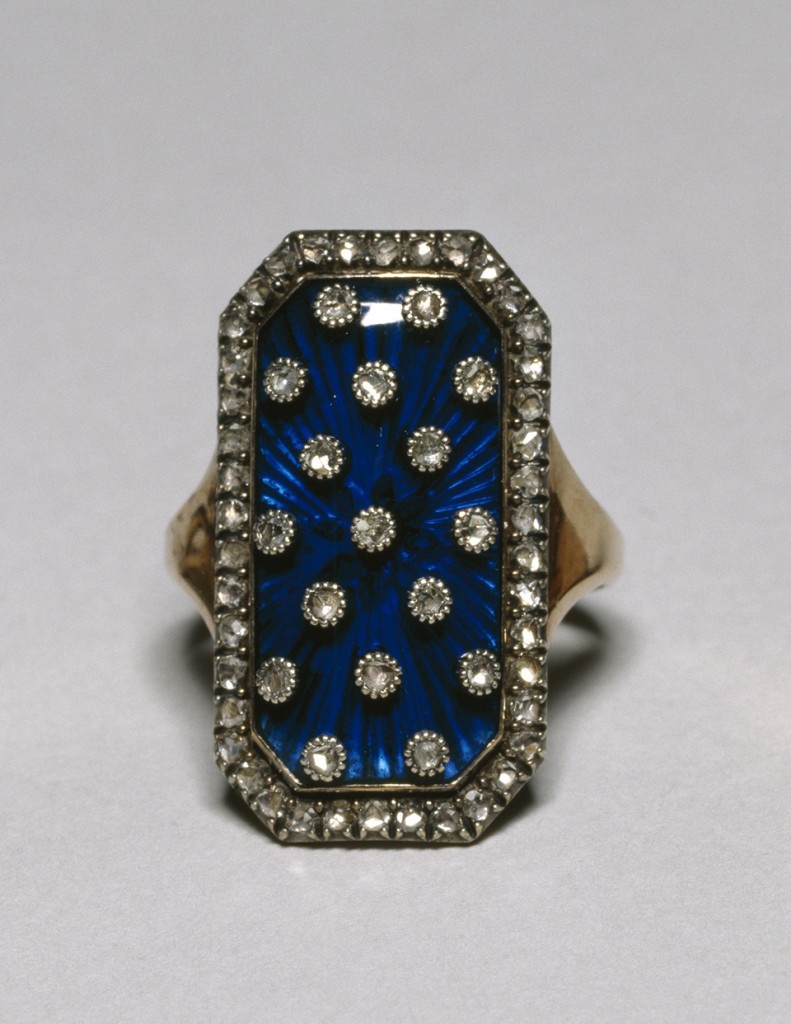
This late 18th century ring is set with diamonds on dark blue enamel. Courtesy: Walters Art Museum, Baltimore.
MYTH: Commercial jewelry cleaning solution or over-the-counter jewelry polish is great for cleaning jewelry at home, as long as the metal type is listed on the bottle.
FACT: Most diamonds can be safely cleaned with a commercial jewelry cleaning solution, but that doesn’t apply to all of your jewelry and gemstones. Begin by looking at the ingredient list on the container. Avoid harmful chemicals like chlorine and other bleaching agents as they can damage some gemstones and metal alloys. Also, don’t use abrasives, like those found in some metal polishes or toothpaste, as they can erode the metal and scratch some gems.
Be sure to consider the precious metal alloy used in your jewelry. Gold is a soft metal. Take a look at an older gold ring, for example. It’s not unusual for the shank to become thinner due to normal wear. Commercial cleaning solutions specifically made for jewelry are a good choice for most gold jewelry items. If the jewelry is set with gemstones, you still need to use caution as some gemstones should not be placed in the solution. Using warm water with a few drops of mild dish soap is the safest alternative if your gold jewelry contains delicate or porous gemstones or pearls.
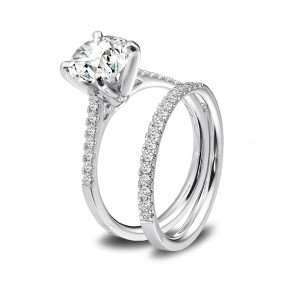
Platinum is a strong and durable metal. A platinum diamond ring bridal set. Image courtesy Platinum Guild International.
Platinum is a metal that doesn’t tarnish and can withstand jewelry cleaning solutions. It has a high density that makes it a very durable metal choice. Sterling silver is also quite popular as a jewelry metal because it is versatile and affordable. However, it takes on an aged appearance as it tarnishes over time. A jewelry cleaner specifically made for silver jewelry, or use a polishing cloth designed for silver jewelry with delicate, porous gemstones or plating, a smart choice to freshen up those tarnished pieces.
Regardless of the gemstone or metal type, it is always safe to use a soft cloth to wipe away the dust and oils that may have built up on your jewelry over time.
4. Warm Water and Gentle Soap
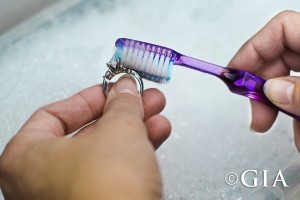
Use a gentle touch when cleaning your jewelry with a toothbrush and warm soapy water. Photo: Eric Welch/GIA
MYTH: All gemstones can be cleaned with warm water and mild dish soap at home.
FACT: This cleaning method is safe for most gemstones.
While this gentle cleaning method is a good choice for most gemstones and jewelry, there are a few important exceptions. Porous gemstones (such as coral or turquoise) and delicate pearls (natural or cultured) should always be kept away from any chemicals. Caution must also be used when cleaning most treated gems. Each gemstone has its own specific cleaning needs. If you have any questions about how to clean jewelry, GIA’s Gem Encyclopedia has beneficial information at your fingertips.

Ruby ranks a 9 on the Mohs Scale and has excellent toughness, therefore is considered a durable gemstone. An 11.01ct oval Burma ruby set in platinum. Photo: Robert Weldon/GIA. Courtesy: Jan Goodman Co.
Are you jet-setting for the holidays? Travel in style with our guide to Traveling with Jewelry.
Main Image Courtesy Platinum Guild International, USA
Custom Field: Array
